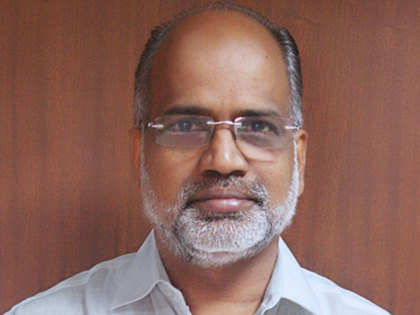Overall, the upkeep is sub-par. The office of Employees Provident Fund Organisation (EPFO) in Bhavishya Nidhi Building truly belongs here. Nothing much seems to have changed since the last time this reporter visited in the early 2000s. A dingy reception welcomes you. For an important organisation that has 18,000 employees, administers a provident fund programme to close to 19.3 crore Indian workers in the organised sector and manages a corpus of Rs 9.8 lakh crore, its office is modest. On the third floor where the Central PF Commissioner (CPFC) sits, the furniture is barebones and the office space spartan.
While the physical space may not change any time soon, VP Joy, the man at the helm who took over the reins in February 2016, vows that he will change the way EPFO operates. “We have many legacy issues. We are working hard to modernise and digitise our operations,” says the CPFC, a Kerala cadre IAS officer.
Multiple initiatives are underway. The journey started in 2014 when Prime Minister Narendra Modi rolled out the UAN (Universal Account Number). Linked to a worker’s permanent account number (PAN) and Aadhaar, every worker enrolled with the EPFO gets a unique lifelong identity number.
This helps in a smooth PF account transfer, avoiding duplication in the event of workers switching employers and cities. For long used to working as islands, 114 of the 123 branch offices of the EPFO have been digitally connected.

Popular in Wealth
The central office now has real-time access to all PF accounts and deposit updates.
Instead of physical applications with cumbersome and time-consuming approval processes, a range of services -- from PF account transfer and partial mony withdrawal to modification in the worker profile and statement update -- can now be done online in a time-bound manner within 10 days. "We are changing our strategy. Instead of putting pressure on workers to not close PF accounts we want to make it so compelling that they stay invested," says Joy. Initiatives like helping workers buy houses and health insurance cover for retired workers under ESIC (Employees' State Insurance Corporation) are on the cards.
Embracing Digital
EPFO’s efforts are being acknowledged. Prakash Rao, vice-president consulting firm, sees a sea change.
By the 15th of every month, employers typically have to deposit the PF money deducted from workers’ salaries with EPFO. Earlier, it had to be deposited by cheque and a physical challan was issued. “The entire process was offline, lengthy and cumbersome. It is now instant and electrons," says Rao.

In the past, each of the 123 EPFO branch offices had its own bank accounts into which companies deposited money monthly. When a worker shifted from one zone to another, her account had to be physically transferred, an elaborate and time-consuming process. "Account reconciliation could take up to four months, " says Joy. With all branch offices connected to a central server and the shift to electronic transaction, it has also become easier for the head office to keep tab on transgressions and defaults on a real-time basis. "This has dramatically improved our default management system," adds Joy.
Sonal Arora, vice-president, TeamLease, a temporary staffing firm, agrees. “We have seen a big change in the way EPFO functions in the last two years. They have become very workerfriendly,” she says.
For instance, earlier when a worker switched employers she had to fill a physical form that had to be signed by the previous and present employers. The entire process could take weeks. Today, with the UAN number linked to PAN and Aadhaar, the task can be done quickly online. Workers can also register on the EPFO portal and get SMS alerts when their PF accounts get credited with funds or interest.
Procedures and timelines around partial withdrawal of PF funds in emergencies too have been overhauled, reducing the compliance burden. For example, earlier if a worker needed to withdraw funds from her PF account for, say, a marriage, she had to submit a claim form with accompanying evidence (like the wedding card) and the form had to be duly attested by the employer.

No longer. Allowing self-certification of several documents, the new claim form can be submitted directly by the worker to the EPFO without employer’s attestation. Of course, (only those who have linked their UAN with their Aadhaar number can avail of this. A utilisation certificate that was earlier required to be submitted has been dispensed with. EPFO promises to deliver these services within 10 days.
“These are big changes. Dependence on employers has been substantially reduced and the timeline too has been cut short,” says Venkatakrishnan Natarajan, CFO, Tata Hitachi Construction Machinery.
Journey half done
Though EPFO has made some good progress, much more remains to be done. For example, in case of a complete withdrawal of funds, the procedure remains cumbersome. Employers’ biggest problem today is poorly equipped EPFO portal. “Between the 10th and 15th of every month, it literally stops working due to traffic overload,” says Rao of PeopleStrong. Employers are trying to find ways to tackle this, with relevant departments uploading data at night when traffic is low.
“Old data too is not available. The government must improve the technology backbone urgently,” says Arora of Team-Lease. Rao suggests emulating the passport office, which has outsourced critical functions to third parties, improving service dramatically.
EPFO too should outsource the digitisation job and build a technology backbone quickly. “Change management of an old culture is always difficult. Digitisation brings transparency which many don’t like. A third party will do a better job in a short time,” he adds.
While fixing glitches, EPFO must also prepare for a broader role in a worker’s life. For example, Joy is exploring ways in which it can partner the government in boosting home ownership among its workers. The Modi government has set a target of housing for all by 2022.
“Who will give a home loan to a worker with Rs 13,000 salary,” asks Joy. Since April, EPFO has been engaging with employers, workers and companies like HUDCO to find ways to make this a reality. Joy envisages that workers could form a cooperative society where they can collectively bargain with a builder for housing. EPFO can do the certification on how much money they have in their PF accounts.
HUDCO could work with banks to offer subsidised home loans. And EPFO can directly release 90% of a worker’s accumulated PF money towards buying their homes. “Annually, we get 1.16 crore claims of which 91.2 lakh are premature closure. Instead of creating hurdles we want to make PF so attractive that workers will not want to exit,” says Joy.
EPFO must take a stab at other bigger problems. Under 10% of India’s 470 million workforce is in the organised sector, who are covered under the EPFO. The challenge is to offer some form of social security to the remaining workers in the unorganised sector who have little knowledge and wherewithal to save for retirement. A recently released vision document by EPFO aims to offer universal social security to all workers under its PF, pension and life insurance program by 2030.
“India might want to look at Singapore for some inspiration,” says Chitra Jayasimha, senior actuary and practice leader, Aon Hewitt. In Singapore, the Central Provident Fund offers compulsory savings plans for all working Singaporeans and permanent residents, which help them fund their retirement, make available healthcare insurance and housing at a very subsidised rate. NPS (National Pension Scheme), open to all Indian citizens, is a step in the right direction. But more needs to be done. A young nation must begin to worry about retirement and old age now to avoid a future crisis.
We want to help workers buy homes: VP Joy, chief PF commissioner


